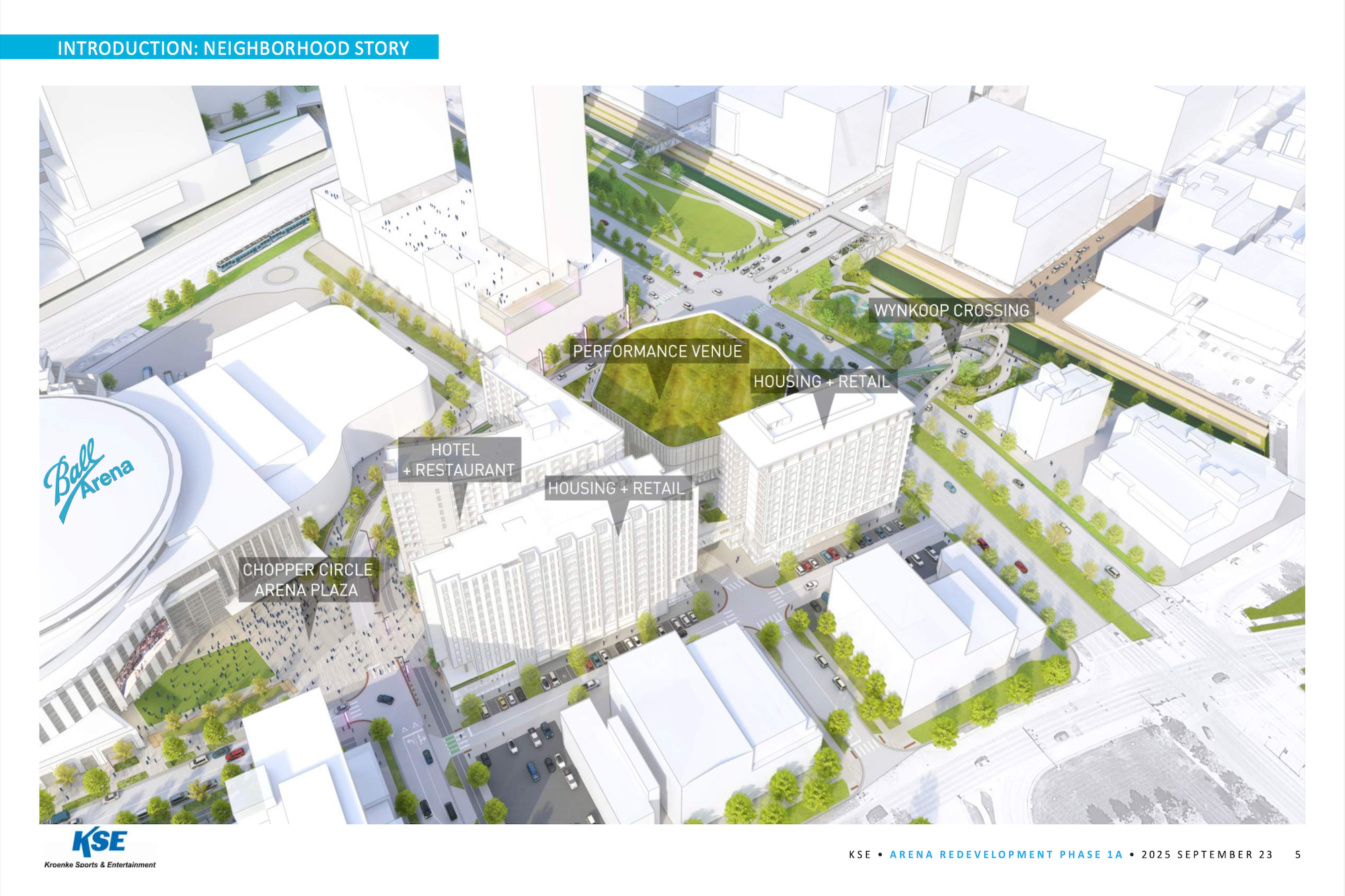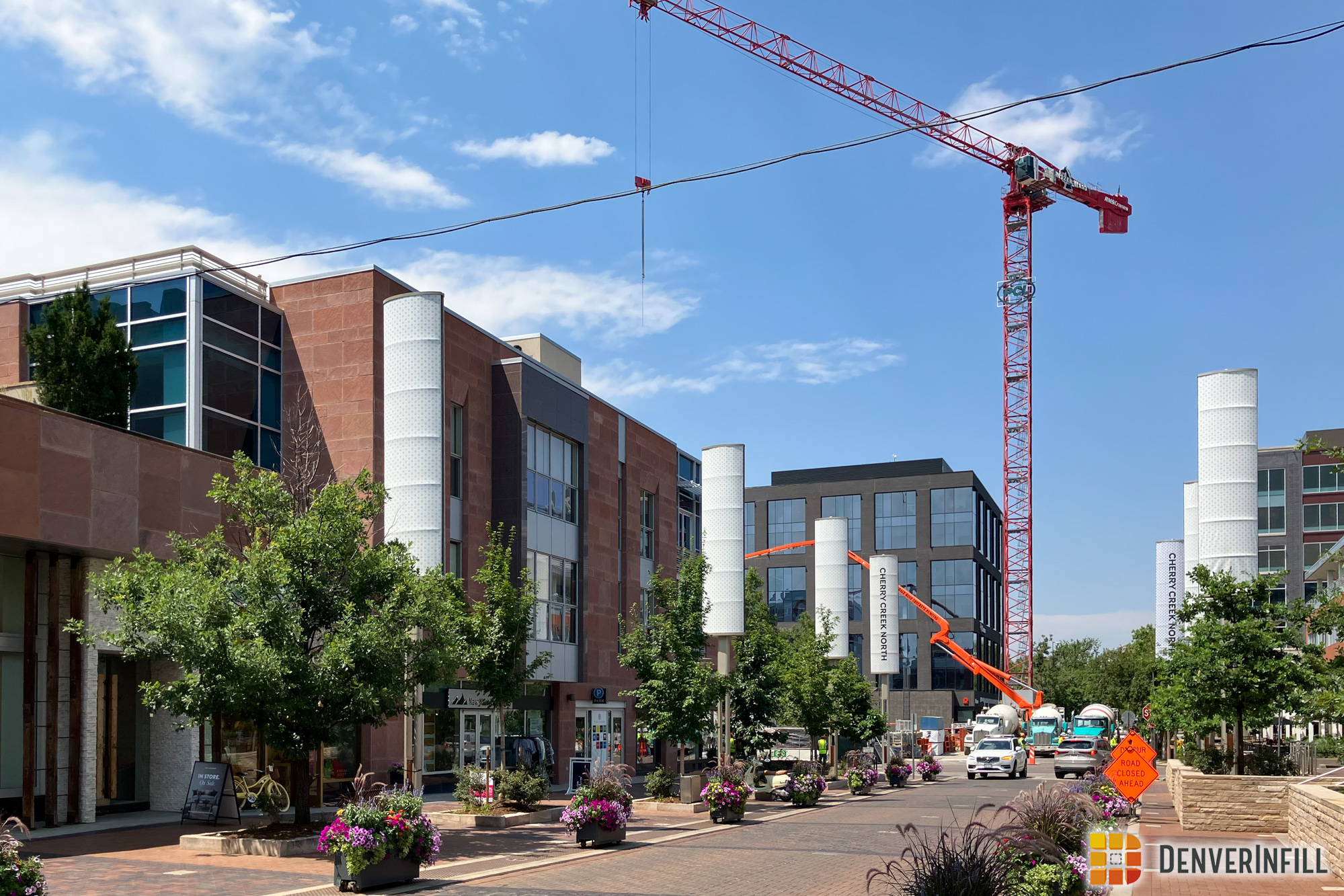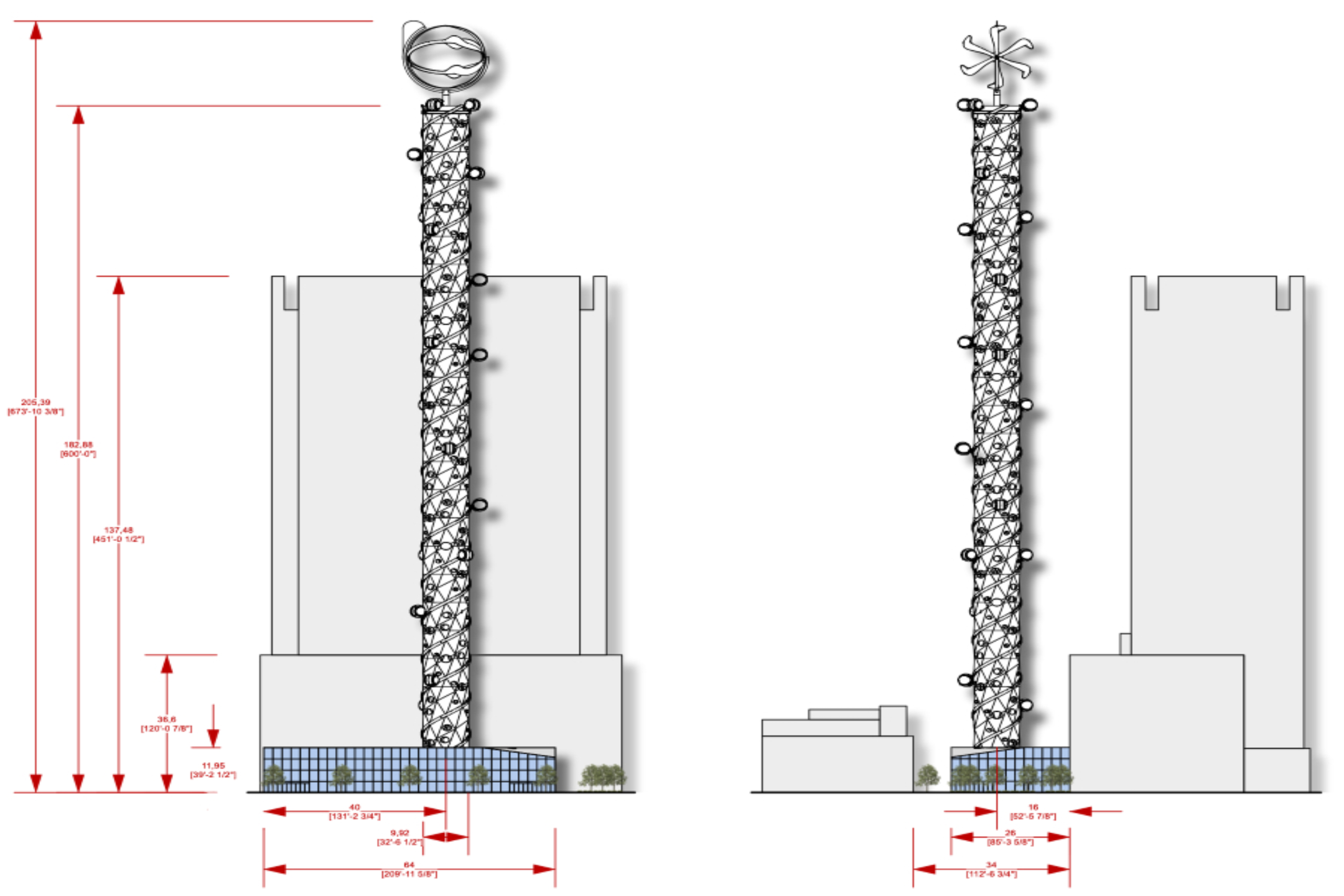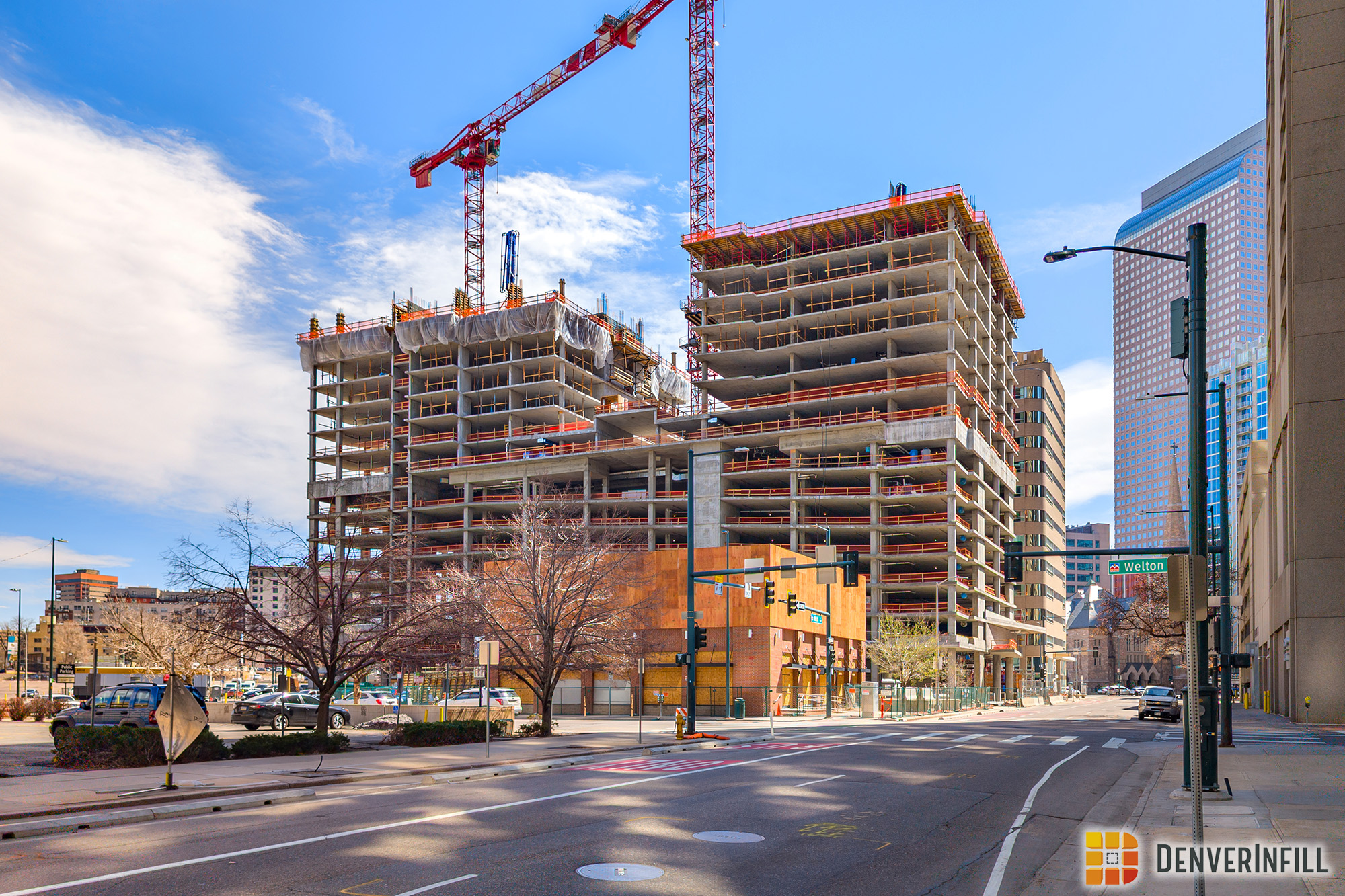Back in late 2012, DenverInfill annonced a new project that was going to carry on the task of helping fill in the Ballpark / Arapahoe Square neighborhood. As we all know, these two neighborhoods are cursed with large parking craters that ultimately hurt Downtown Denver’s urban fabric. With 2020 Lawrence wrapping up, Legacy 22nd, now known as Point 21, started to take off. Below, you can click through the links and read through this project’s story; from exisitng buildings on site to construction activity to, now, the final product.
New Ballpark Project: Legacy 22nd
Ballpark: Legacy 22nd Update #1
Ballpark: Legacy 22nd Update #2
Summer 2013: Downtown Denver Hole-in-the-Ground Census
Ballpark: Legacy 22nd Update #3
Ballpark: Legacy 22nd Update #4
Point 21 rises a total of six-stories and provides the Ballpark neighborhood with 212 apartment units. Let’s start off with a photo showing the project from Larimer Street. This is a great example of what an urban neighborhood should contain: a great street, in this case Larimer Street, sporting healthy ground floor retail with residential units lining the streets behind.
Point 21 takes the entire half block along Lawrence Street with a very large setback in the middle, where the amenity deck and parking ramps are located. On both corners of the block, this project appears to be two buildings eliminating the visual of a large, overbearing street wall of apartments.
New projects around the Ballpark and Arapahoe Square neighborhood have tapered off for the time being but I would expect another wave to commence soon, given Downtown Denver’s hot rental market. Welcome to Ballpark, Point 21!
















I would’ve liked to see a few more street trees, but it turned out well. And wow, seeing the old 2012 aerial photo reminds me how many surface lots there used to be. Bleh.
It appears this development has absolutely little, to no retail in it? Oh, wait..! They have a “fitness center”. 🙁
Definitely a loss with so few trees, and zero commercial. Too bad each “tower” didn’t have some unique variation to break the block up a bit better. 6 stories looks great here, though.
Why have retail in this building when Larimer (one block over) has blocks of it in this area? Not every project needs ground floor retail, especially that close to an already established retail corridor! 🙂
Agreed. Not every project does need retail… but I think when a building takes up an ENTIRE city block it should have a few (even smaller) spots to house some kind of flexible commercial space. Its the same concept as you’re referring to with the “retail corridor”. Its equally important on smaller scales as well—otherwise you get dead (streets) zones, much like the other blocks built 10-15 years ago that lack ground floor commercial. A more consciously designed building would at least add residential entries along the street (much like 22nd & Blake). Conceptually, the plan is to activate the streets, not just fill them.
I completely agree Ryan. There was no need for retail here when there is retail at 2020 Lawrence that I believe is only 75% leased???
I think what could’ve been done better here would’ve been to create a better pedestrian amenity zone like they did at the Douglas down the street. The trees are nice, but planter boxes would’ve been great along with benches, etc.
Agreed. Ground floor retail is not always warranted and oftentimes is imposed on projects that do not need it. Vacant retail is a horrible way to activate a street. A “fitness center” with lights on and people using it actually does provide some street activation and eyes on the street, which this area of town continues to need.
I agree with all the statements above. I don’t think having ground floor residential units for half a block is the best use for a couple reasons. I think that 10-15 years from now, there will be a critical mass of people in the area and retail will be appropriate. The other reason is that those units would be less appealing to me for privacy and security concerns. However, I also agree that as of now, retail isn’t really necessary and could create different problems. Namely, it isn’t good for the developer or the residents to have empty retail space. I wonder if there are other uses besides the “typical” retail that would work in these areas? An idea could be a bike depot like the one going up near the Triangle Building or maybe co-sharing work spaces. As the area progresses, these places could be turned to traditional retail as demand increases. Finally, if retail or some other creative use just won’t work, I would want a nice landscape buffer. Something more than a few pots thrown out there but an actual landscape bed with shrubs and trees or maybe a small wall to give some visual interest and separation for the tenants.
This would be an issue if the density of the area demanded it, but downtown Denver simply isn’t there yet. All you end up doing is diluting the potential business for existing commercial areas, and that won’t help anyone.
We are dozens of these buildings and many thousands of residents away from needing to get vigilant about retail space in every new development.
Nice presentation. Thanks for the final update on this project as well as the Amaranth.
I assumed this project would be more basic but I think it turned out fine; I like the colors, building separation and amenity deck visual.
there’s so many of these things these days, just big block long appartments with uninspired architecture and limited ground floor retail. its obviously better than a parking lot, but these structures are so formulaic and really starting to pop up everywhere in in places all over downtown that i can’t really say one more key card entry building is all that exciting.
I hear this concern a fair amount, both in comments on this blog and in Denver more generally, but while I appreciate good architecture, that critique strikes me as a little unfair to Denver. Unremarkable three- to eight-story residential structures are the building blocks of most iconic cities in the western world, which leads me to believe that putting people in close proximity to one another counts for more than does visual appeal. Granted, Denver could use some narrower streets (and a climate better able to support trees) but check out the following examples:
London – https://www.google.com/maps/place/London,+UK/@51.526897,-0.125694,3a,75y,328.78h,93.15t/data=!3m4!1e1!3m2!1s4gmOM-m7BrJ5U_tXz5IO5w!2e0!4m2!3m1!1s0x47d8a00baf21de75:0x52963a5addd52a99
Boston – https://www.google.com/maps/place/Boston,+MA/@42.35348,-71.079708,3a,75y,246.85h,89.63t/data=!3m4!1e1!3m2!1smx_43sPI_Og2zY7ArU3mjw!2e0!4m2!3m1!1s0x89e3652d0d3d311b:0x787cbf240162e8a0
Paris – https://www.google.com/maps/place/Paris,+France/@48.87771,2.314707,3a,75y,271.12h,93.23t/data=!3m4!1e1!3m2!1sooPvobkZV3LWFKiDmdk_hw!2e0!4m2!3m1!1s0x47e66e1f06e2b70f:0x40b82c3688c9460
Buenos Aires – https://www.google.com/maps/@-34.591442,-58.390241,3a,75y,311.99h,90.82t/data=!3m4!1e1!3m2!1sPn1iiZvdyAMFO4BU_1UGTg!2e0
New York – https://www.google.com/maps/@40.72809,-73.982823,3a,75y,295.14h,97.14t/data=!3m4!1e1!3m2!1s_dydQEMJH6L6nPaDuKcF_A!2e0
Chicago – https://www.google.com/maps/@41.938705,-87.642507,3a,75y,83.53h,89.61t/data=!3m4!1e1!3m2!1sE5BLo7d_TnJOaUAXWwERvg!2e0
Denver – https://www.google.com/maps/place/Denver,+CO/@39.747257,-104.978754,3a,75y,173.11h,86.99t/data=!3m4!1e1!3m2!1saKpgnFoRmSnoWq-5u1Qcww!2e0!4m2!3m1!1s0x876b80aa231f17cf:0x118ef4f8278a36d6
Andy P… Nice fun links; thanks.
Denver = progress.
Uninspired architecture /is/ the problem. Take Boston as an example. This sort of simplistic and yet visually appealing style is what Denver could’ve looked like without a history of demolition.
I argue for restoring the City Beautiful Movement in Denver, which not only created a world-class city but gave us the many landmarks and favourite spots we have today. Sure, some of the apartment buildings need to be cheap and go up quickly, but we’re only creating buildings that will look garish and outdated five years from now. Let’s create buildings that end the boom/bust, build/demolish cycle in Denver.
Beauty is subjective. I don’t know what you see when you look at your European and East Coast examples, but I see beautiful neighborhoods made up of beautiful buildings – relatively ornate buildings of high-quality. And I don’t see any buildings that span the length of an entire city block. Then when I look at your example of Denver, it’s a bit depressing in comparison. But I suppose it should pale in comparison to those world-class cities. Those other cities were built up into dense urban places during a different time.
Overall, I’m very happy with the increasing density of my home town. I’m excited to see all of the new development. But I can’t help feeling a little embarrassed for my home town on occasion when I see some of these cheap-looking, utilitarian buildings dwarfing their elder neighbors. When Denver’s all grown up, some of it is going to consist largely of these newer, cheaper buildings.
I have to say these cheap, massive buildings are going up everywhere though – even in New York. It’s just the predominant way things are done these days. Also, there are some dense, urban neighborhoods in cities like New York that are truly ugly in my opinion. I recently visited some friends in Bushwick, Brooklyn. Half the neighborhood looked like it was made of tin. I couldn’t believe someone at some point thought it was okay to build all those tin buildings.
The build new 1/2 block apartment buildings in every city in the U.S. and Canada in areas of redevelop like Ball Park, etc. I have been to every major city in North America for work. Paris, Barcelona, and Madrid in particular have very large apartment blocks some of which are close to two hundred years old and the suburbs of European cities have truly enormous apartment complexes that are really depressing. I don’t see why people have an issue with these larger apartment buildings in neighborhoods that were nothing but warehouses and parking lots. Most of Denver is made of smaller apartment buildings and houses (Capitol Hill, Cheeseman, City Park, etc.) anyway. These larger buildings can also offer amenities like swimmimg pools, community areas, and fitness rooms that small, old, “quaint” buildings don’t have.
Beauty and aesthetics are subjective indeed. This is a topic that always fascinates me, as people clearly look at the same pictures and see different things. Take that image from London, for example. None of the buildings take up an entire block face, that’s true (and a valid criticism). But for me, that’s where the quality differences end. Take the brown building on the left side of the London image. It’s clearly post-war architecture, rather bland, with a flat roof, little ornamentation of the windows, cornice line or otherwise. In fact the only building in that image that I would consider “pretty” in the traditional sense is the smaller, older one to the immediate right when you load the page.
Similarly, several of the mid-century buildings in the Chicago street scene are equally ugly and replaceable. Even in the New York example, not all of those tenement buildings are “good architecture.” Again, they were built in a different era and therefore could be built with smaller floorplates on smaller lots, but only some of them have ornate cornice lines. Many have bland, “flat” rooflines and very plain “boxy” window articulation.
I actually find it quite fun and interesting to discuss these details and the architecture for its merits. There are good buildings and bad buildings, good techniques and bad ones, and most people will never completely agree. What gets tiring though is the suggestion that Denver is singularly bad, backwards, or wrong just because not every building is an architectural masterpiece. The reality is that there are “bad” buildings in every city, and giving architects the freedom to fail is also what gives them the freedom to progress. And let’s be honest… Denver has gotten some real gems out of this building cycle too, so there is nothing new going on here if you ask me.
i totally agree, these structures are building blocks towards a larger urban fabric, and ultimately its regrettable that so much of LODO was demolished in the 70’s and 80’s. At the same time, if all of the Denver urban core looked like this in 10 years, i think it would be just as regrettable, and so i think it is important to design buildings that place an emphasis on ground level retail and materials so as to provide a long term aesthetic that is fun and opens up the city to residents and visitors alike, and that people chose to have a say in these matters.
This building seems to have gone up surprisingly fast. Nice filler building. Unless I missed it, Ryan, you never did a final post on the apartment building at 22nd and Blake. I think it is called Broadstone on Blake?
With the party pool deck and prominent fitness center this building screams for recent college grad transplants for tenants. Looks like fun!
Hey, think how far “Urbanism” has come, from so-called “City Planners” managing the bulldozing of dozens of Downtown blocks 60 years ago — and “planning” a freeway through LoDo and Curtis Park to I-70 — to debates today, like the one above, over whether an Infill project should have some retail. The real victory is the dozens of Infill projects, transforming those ugly surface parking lots we’ve been looking at for more than half a century!
Correct me if I’m wrong, but to clarify, this building did not just replace a parking lot. It replaced a great little old brick building that was torn down. “Better than a parking lot” isn’t how I am evaluating this truly mediocre building.
Just to clarify a few things. Yes, there was a “old brick building” that was torn down. The portion of that building that fronted the street was a rather nondescript, single story building (not substantial loss), but the rear portion was far more interesting. It is a shame that it was/could not be integrated into the new building. However, 2/3 of this block was surface parking and I am very glad that it is gone. There are some residential entries on the ground floor: four along Lawrence and two each along 21st and 22nd. There should be more trees, but those can be added later. I am not a big fan of the design of the main entrance and “fitness center” section. It seems very out of place and too contrasting with the remainder of the street frontage. I also wish the developers had kept the exterior window moulding like what was seen in the renderings. Much nicer.
This looks great..but there is absolutely no reason they should have a curb-cut off of Lawrence – car entry and exit is part of what the alley is for. Denver has an ordinance for this, but it may not apply in this zone district. Nevertheless, design review should have pushed this issue.
I agree with Bobby and LB. this building is uninspiring and completely unimaginative. angreat contender for Denver FUGLY blog
I think a lot of the “problem” with these buildings is right now they stand as monuments on an otherwise empty block or group of block, so they are very noticeable and very easy to focus on and critique because of that. Just look at those examples Andy P. so graciously posted above, many of those buildings would be just as “ugly” and out of place if they just stood on a block by themselves.
Once the entire blocks surrounding these buildings in ballpark, arapahoe square, etc. are redeveloped with similar scale and format, we won’t even notice these buildings anymore, they will just be part of the urban fabric and Denver will be much better off for it.
Parking necessities make the smaller footprint buildings much more difficult to pencil out because the numbers just don’t work for the developers when they have to spend a lot of money on parking as a square footage vs. the number of residences in the building. Smaller garages are much less efficient. They could design the block long buildings with broken up facades (and some have), but there is nothing in the zoning that states they are required to do so, so many developers won’t spend the money obviously. It’s not up to the developer to make the city look or feel a certain way, they build what they can within the limits of zoning, its the cities job to regulate what gets built if that is really felt to be necessary.
Can we get an update of some kind? It’s been almost two weeks. Tere have got to be more developments to talk about that this.
I feel lucky and appreciative that we get updates as often as we do. Ken (and more recently Ryan) have been making this website in their spare time for 10 years. If you’re interested in more frequent updates and conversation, consider looking at the Mountain West area of Skyscraperpage.